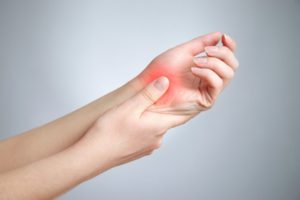
Thumb joint pain sign and symptoms
This type of pain can occur with stiffness, swelling, and tenderness. While the pain may start occurring only when you attempt to perform specific actions, such as gripping, it can worsen into inflammation and chronic pain. This constant pain can affect your ability to open doors, button shirts, and tie shoes, making thumb joint pain a bigger hindrance on your life. Your range of motion with the digit, as well as grip strength, can also worsen if the condition is left unchecked.
Causes of thumb joint pain
Thumb joint pain can be the result of a variety of different issues, ranging from injury to disease, and it could even be caused by the excessive use of modern technology. Find out what’s causing your thumb pain below.
Bennett fracture: A Bennett fracture at the base of the thumb—most often caused by a fall or a hard punch—can cause severe joint pain and swelling.
Rolando fracture: Another fracture found at the base of the thumb, although a Rolando fracture is more severe as it occurs when the base fractures into multiple pieces. Rolando fractures almost always need surgery, and although they are rare, thumb pain can last for months afterwards because of pre-mature arthritis.
Extra-articular fracture: This type of fracture is much less severe as it is a simple fracture to the shaft of the small bones known as phalanges. It usually doesn’t require surgery and heals without any invasive procedures.
Ligament injury: An injury to the ulnar collateral ligament, or UCL, is a common result of some sports and is known as “gamekeeper’s thumb,” or “skier’s thumb.” Falling on the thumb stretches the ligament and causes damage that results in swelling, joint pain, and severe bruising at the base.
Thumb dislocation: There are two major joints within the thumb that can become dislocated: the carpo-metacarpal joint (CMC) found at the base of the thumb, and the inter-phalangeal joint found between the phalanges. Dislocation of the CMC is more common, and pain is felt when the patient attempts to move the thumb, though there is less swelling than what occurs with other types of injuries.
Carpal tunnel syndrome: Carpal tunnel syndrome occurs when the median nerve is compressed at the wrist and can cause thumb joint pain, tingling, and numbness.
Rheumatoid arthritis: This form of arthritis can cause inflammation of the tendons surrounding the thumb, resulting in tendonitis and causing pain in the joint.
Cellphones: Your thumb can be damaged by constant typing on your mobile device. This injury is referred to as a repetitive stress injury, or more commonly, “Blackberry Thumb,” and can cause pain in the thumb joint.
Keyboards: Those who consistently use a keyboard for work or pleasure and type with both hands may develop carpal tunnel syndrome, causing thumb joint pain or numbness. Regular use of keyboards may also cause joint pain similar to that experienced with De Quervain’s tenosynovitis.
Potential complications of thumb pain
Thumb pain may be more serious than just a damaged ligament or small fracture, and as such, there are a host of complications that may arise.
- Abscesses
- Amputation
- Joint Deformity
- Muscle Weakness
- Paralysis
- Sepsis
If you are experiencing joint pain and are concerned about your symptoms, be sure to see your doctor to prevent it from getting more severe.
Related: Increasing number of Americans suffer from joint pain
Thumb joint pain treatment
There are a variety of treatment options for dealing with thumb joint pain, though it is important to seek the advice of a medical professional before beginning any treatment regimen to ensure you do not worsen your condition.
Rest: One of the most important things you can do for any joint injury is allow the affected area to rest. Refrain from using the thumb as much as you can so it has time to recover and heal properly.
Anti-inflammatories: Over the counter anti-inflammatory medications or creams can help reduce the swelling around the joint and minimize pain. Ice is also good for bringing down any inflammation, and rubbing an ice cube over the joint for a few minutes at a time can help reduce the discomfort associated with swelling.
Ultrasound: As part of a physical therapy regimen, ultrasounds can be used to help raise the temperature of the affected tissue and increase healing.
Stretching: Certain stretches can prove to be beneficial for thumb joint pain. Some of the most common ones are thumb abduction stretches, which require you to gently pull your thumb away from your palm with the opposite hand for approximately 20 seconds.
Thumb injuries are very common and can be caused by anything from too much texting to carpal tunnel syndrome. If the joint pain is persistent or concerning, contact your physician to receive a proper diagnosis and prevent any further complications.
Related: 7 easy fixes for nagging joint pain